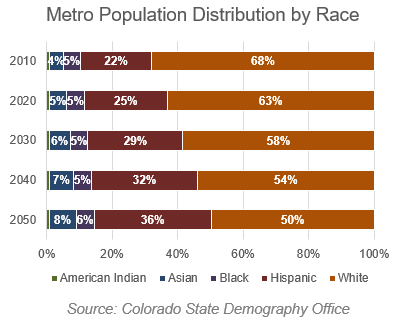Cultural Competency Requires more than Translations
12/9/18 / Matt Herndon

We at Corona have the privilege of working with a wide variety of arts and culture organizations in Colorado and beyond. One of the biggest challenges we hear a lot about these days is providing programs and services that will appeal to a group of culturally diverse audiences. In the Denver metro, where we do much of our work, the percentage of the population that is White is expected to decline from 68% in 2010 to only 50% in 2050, so tackling this issue is critical to the success of the arts and culture sector in the state.

For a long time, it seemed like most arts and culture organizations’ approach to cultural competency was to offer translations of materials in other languages. While there is certainly nothing wrong with providing translated materials for non-English speakers, and it is often the first step many organizations take in trying to be more relevant to underserved cultures, there is a big difference between simply providing translations and being culturally relevant. The key question we have recently been asking our clients to consider is what it means for an experience to be designed with diverse audiences in mind compared to an experience that has been adapted for diverse audiences from an experience designed for a non-minority audience. In the former case, the experience should seem instinctual, organic, natural, and welcoming. In the latter, the experience can come off as contrived and inauthentic.
It is important to consider that the definition of “diverse audiences” varies greatly by region, and a truly diverse approach will consider how the experience will reach audiences of all types. However, for the purposes of this discussion, we will focus on some things we have learned about how Hispanic families in Denver experience arts and culture to illustrate ways in which translations don’t go far enough.
Imagine that you were designing an experience and wanted to ensure that it would be relevant and inclusive for Hispanic families. Rather than thinking about how a non-Hispanic family might enjoy the experience and then providing translations, here are a few things to consider:
- Many Hispanic families are multi-generational, and grandparents are deeply involved in the lives of their grandchildren. An experience for Hispanic children, therefore, may be more successful if it includes seating areas for grandparents who might otherwise wear out after standing for a long time.
- Many Hispanic families value free play more than their non-minority counterparts, so having an experience that is highly structured may not translate well. Instead, allowing plenty of time for kids to explore and learn on their own may be more successful.
- Similarly, the ideas of highly-structured questionnaires as a means of evaluating either child performance or program success may not be effective among Hispanic audiences. Culturally, the idea of answering closed-ended questions in a very impersonal experience is somewhat foreign compared to a conversation with friends about a topic, so qualitative approaches may be more successful than quantitative approaches.
Of course, these are just a handful of things to consider out of countless ways that Hispanic families might vary in how they take in an experience, so the long-term solution to the challenge of being culturally relevant to all families is to ensure that you have representation among your leadership and staff from the various segments that you are trying to reach. While you are trying to get to that point, though, keeping in mind that experiences should be designed for diverse audiences rather than adapted for them will help to put you on the right track.